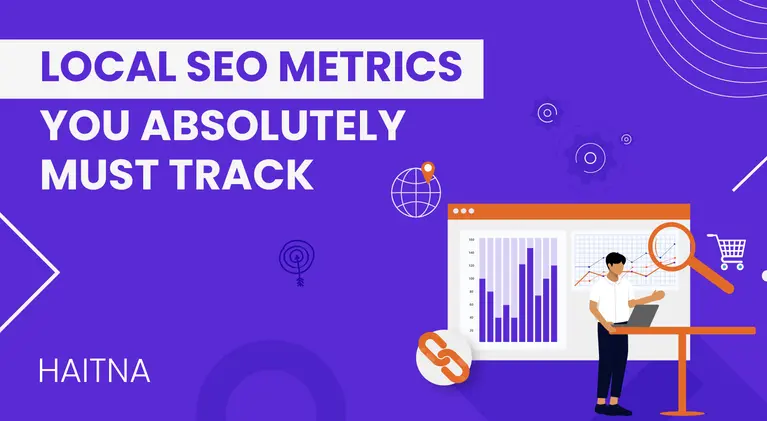
20 Local SEO Metrics You Absolutely Must Track
Intro
There are a million businesses out there, and each one has one goal in mind: to gain more customers. A strong digital business is critical for any brand to emerge successfully. SEO becomes a vital aspect to consider.
To see success in digital marketing for your business, you must implement and curate the right SEO strategies.
These are the 20 most important SEO metrics you should start tracking right now if you wish to grow your online business.
20 of the Most Important Local SEO Metrics to Track
1. Page Load Time
The most important metric to track for SEO is the page load time. This is also because it determines the bounce rate. According to Google, when page load time increases from 1-6 seconds, bounce rate increases to 106%. Besides, a slower website can also impact your ranking.
Tools to track page load time:
- Uptrends has worldwide servers, so it is a good tool for those with a global target audience to ensure their load times comply.
- Dotcom-Monitor lets you check your website's speed from over 25 locations in just one click.
- You can check metrics like full load time and first byte load time with Website Audit.
Here’s a screenshot of a page load report by Uptrends:
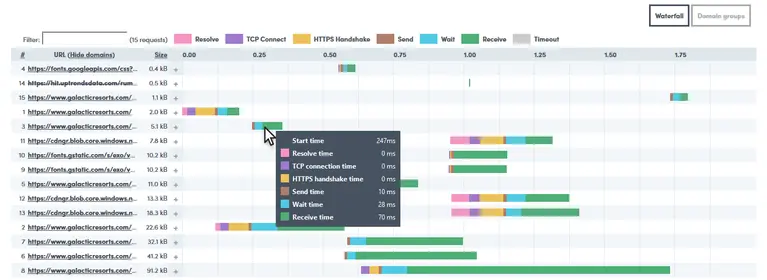
Read: Tips to Increase Page Loading Speed
2. Backlinks Toxicity Score
Backlinks are not all created equal, and in trying to accumulate them faster, you might end up adding some toxic ones. Too many backlinks of this type can negatively affect your search engine optimization. It is always advisable to start from the basics and work your way up in SEO than shortcuts.
A few things to remember while adding doing backlinking are:
- Don't accept links from outside your scope and domain. Remember, relevance is everything.
- Regularly audit your backlinks using Ahrefs, SEMrush, Moz, Majestic, or SE Ranking tools.
- You can use a toxic backlink checker to determine why a link is toxic so that you don't add them to your website.
- Some straightforward toxic backlinks are from penalized domains, directories, link farms, foreign language sites, and so on.
Here’s a screenshot of SEMrush auditing a website’s backlinks:

3. Keyword Ranking
Top keywords keep changing with changing trends, and this is why you have to keep a tab on this particular metric closely. Last month, what was ranking might not still be in its first position in the listing.
Keywords help you benchmark your content, directly affecting its rank on the search engine pages. Branded and non-branded keywords make up to give you the best results. For instance, 'running shoes for women' is a long-tail keyword that influences customers in decision-making.
Here are a few tools you can use to monitor how your keywords are constantly performing:
- Adding Keyword Surfer to Google plugins directly displays keywords whenever you enter a search term.
- Using AnswerThePublic is a great way to discover what questions people are looking for in a particular search term.
- Keyword Sheeter pulls Google autocomplete results and gives live data on what people search for.
Here’s a screenshot of AnswerThePublic showing what questions people are searching on the web:

4. Visibility
Local visibility is very important, especially if running local SEO campaigns. Under these metrics, you will track if enough traffic is coming from the right sources or the right audience that you are targeting. You can do this by keeping track of the following:
- Google My Business - Insights from Google My Business are great to gauge how you are performing online. Set up your GMB account and keep checking how frequently it comes up in result pages for directions, numbers, and addresses.
- Location - Keep track of the session locations. Search results will help you understand what area or location generates more traffic.
- Google Maps - Many rank trackers will track your Google maps rankings. You will add your Google Maps to the rank tracker and measure it.
Here’s a screenshot of Google My Business:
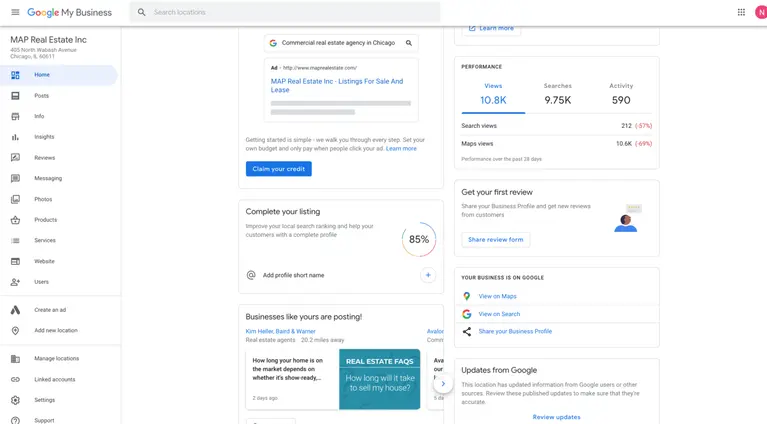
Read: Step-by-step Setup Guide for Google My Business Set up
5. Organic Traffic
Organic traffic is the best indicator of how well your SEO techniques work. The essence of SEO is organic traffic, and the more you work on this metric to rank naturally on search engines, the better your online reputation will be.
Another incentive to track this number is that you'll be able to see which pages are ranking first. For example, if one blog's page ranks on page 1 and another rank on page 6, you'll know which one requires more SEO.
When weighing this metric, keep the following in mind:
- Using long-tail keywords, marketing content on social media, utilizing on-page SEO, and detecting non-performing content are some of the best strategies for organic search traffic.
- Analyze data across numerous devices, as the responsive design is important in assessing organic traffic.
- Check conversions with Google Analytics, SEMrush for all-in-one SEO tracking, and MonsterInsights, especially if your website is built on WordPress.
Here’s a screenshot of Google Analytics assessing traffic metrics:

6. Online Reputation
Your online and offline reputation determines the value of your company. For many brands, reviews and feedback serve as social evidence.
Many shoppers ponder about this before ever picking a brand. Not only do reviews and ratings help your business grow, but they also help you rank higher in search engines.
- Sentiment Metrics allows you to track the mentions of your business on numerous websites, such as blogs, forums, and publications.
- You can gather all of your reviews in one dashboard for simple viewing and analysis with ReviewTrackers.
- Yotpo assists you in improving your brand's reputation by encouraging customers to leave positive reviews.
Here’s a screenshot of ReviewTrackers:
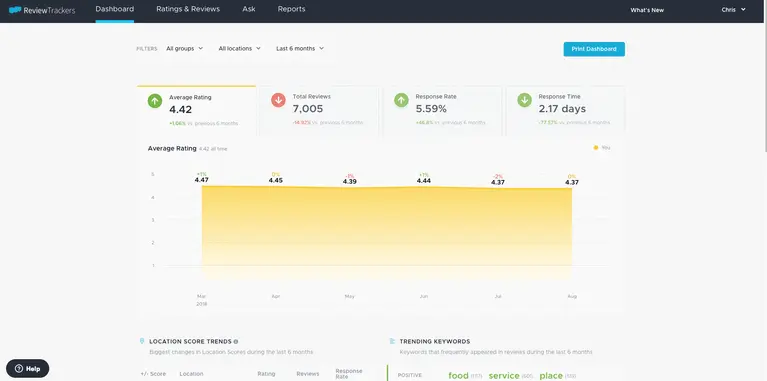
7. Top Exit Pages
If someone is leaving your page, it is because of a certain piece of material or a particular page that they do not like. It is critical to evaluate this measure regularly to ensure accuracy and identify the problematic page.
Exit pages are the pages that a consumer looks at last before leaving the website. Visitors lose interest in the site because of these pages or their material.
These four easy tactics will help you improve the ranking of your departure pages:
- Recognize the reasons why your clients are departing. Exit pages can be identified using website analytics tools.
- Encourage people to stay on your page if they are about to leave. Use pop-ups with suggestions or some takeaways, such as free materials, to do this.
- Map your conversion funnel with exit pages to see where individuals are in your conversion funnel and make any modifications or tactics.
- As a last option, you can use a creative pop-up to ask visitors why they're leaving. This is the most effective method for locating the source of the problem.
Here’s a screenshot of Google Analytics showing exit page metrics:
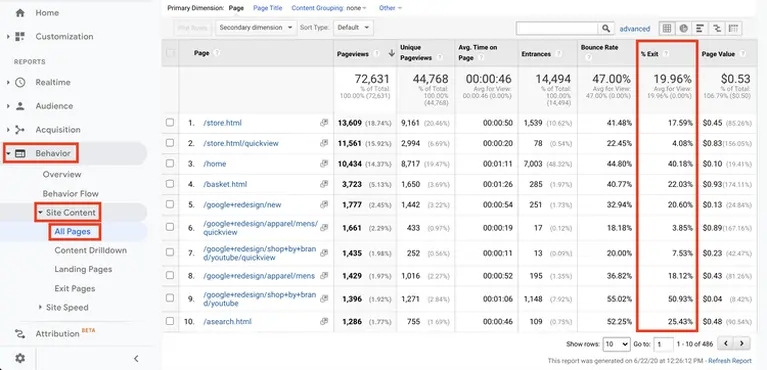
8. Crawl Rate
Even before a search engine indexes a page, it crawls the page. There are three basic crawling issues - the page that you want the search engine to crawl does not crawl at all. This could happen if you have accidentally prevented it from being crawled.
Second, when the search engine crawls too many unimportant pages and content. Third, when a search engine faces an error or issue while downloading a particular URL. Not monitoring these can negatively impact your position in search engines.
Use these tools to fix various crawl errors:
- Google Search Console is the easiest tool to check crawl errors categorized as site errors and URL errors.
- With ISUP.me, you can instantly know if the site is down for just you or across the search engine.
- Fetch as Google will help you check if the Googlebot can crawl to your pages.
Here’s a screenshot of Fetch as Google:

9. Scroll Depth
Scroll depth is how far the visitors scroll down on your web pages. It is essential to know this as it helps you figure out the exact point where they are losing interest.
This could be a piece of content, how the UI works, or anything else. It is important to measure this metric because it will help you make necessary changes in your webpage as it is the first interface that your visitors and customers encounter when it comes to knowing a brand.
- Google Analytics is an easy-to-access tool that will help you check scroll depths at 25%, 50%, 75%, and 100% scroll length.
- Crazy Egg has a scroll map feature that will let you analyze your scroll depth using data and visitors' behavior from your website.
- Use the right code to set up your scroll depth identifier in your Google Analytics.
Here’s a screenshot of Google Analytics displaying scroll depth:
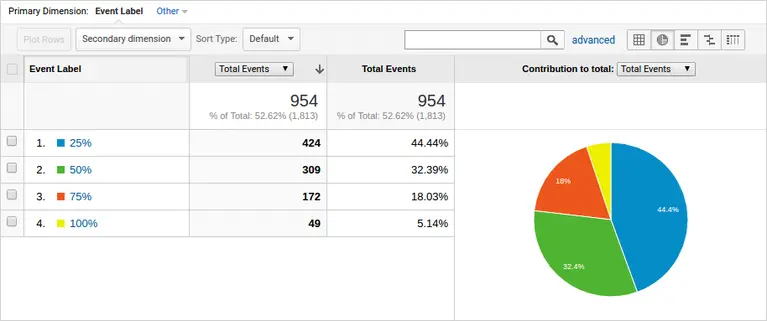
10. Duplicate Content
When it comes to website content, duplication is a big NO. When multiple pages on your website ahs similar or the same content and description, it prevents Google from crawling any further as the search engine will identify and group them as similar pages.
This can negatively affect the topical authority of your domain, which will dilute your position in search engine pages.
- One simple way to avoid this is to write creative and unique content consciously. Remember, there's a huge difference between taking inspiration and copying the same content.
- Use Google Webmaster Tools to identify duplicate descriptions within your pages. Meta descriptions are essential and help better crawl, so fix the duplicate ones as soon as you spot them.
- Copyscape is a simple tool to compare content you have written against the published articles. It will also show what percentage of content you have written already matches your site's existing content.
Here’s a screenshot of Copyscape looking for duplicate content on the web:

11. Click-Through Rate
If you want to know how many people are influenced by your content, you must keep a close eye on this metric.
Click-Through Rate or CTR is a metric showing an average number or percentage of people that clicked through your links after seeing them on the search engine. This tells how appealing your content is to readers.
Here are quick tips to achieve decent CTR.
- When creating content, match your title and meta description to the search intent.
- Using dashes, pipes, and brackets can make your content stand out, making people want to click it.
- Use descriptive and short URLs and if possible, make sure it has a keyword in it.
- Keep defines the formula to calculate CTR as CTR = (Number of clicks / Impressions) X 100
- Have a good website design and ensure you have strong and compelling call-to-action buttons.
Here’s a screenshot of Google Analytics showing Click-Through Rates:
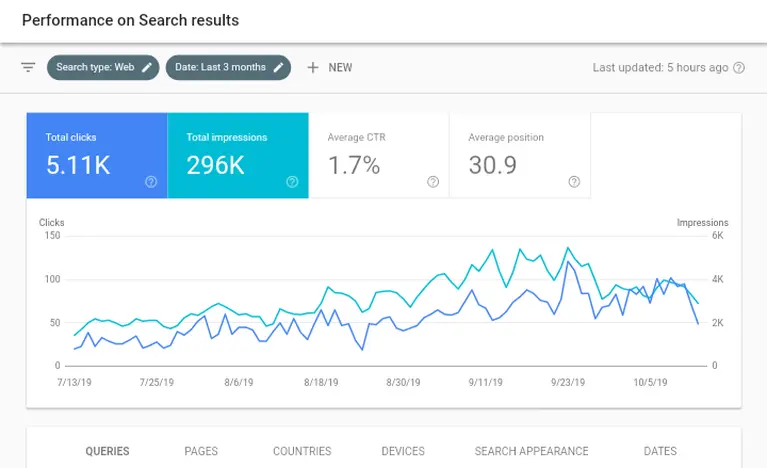
12. Bounce Rate
When someone sees your website for only one page and then leaves, this is known as a bounce rate. This suggests they aren't finding anything else on your website to keep them interested.
Bounce rate is a critical issue because it signifies fewer visitors, which might hurt your search engine ranking. To lower the bounce rate, you must provide an exceptional experience for your visitors.
Here are some helpful tips:
- Always keep your content on point than beating around the bush. A quick, simple, straightforward content is always appreciated and preferred.
- Improve page speed. This is essential to ensure your webpage has the least bounce rates. A visitor does not prefer to have kept waiting.
- You can use SEMrush, Google Analytics Tool, and Alexa Traffic Analytics to identify your bounce rate.
Here’s a screenshot of Google Analytics showing bounce rate:

13. Domain Rating and Domain Authority
You should monitor this metric to discover how strong your SEO is. Backlinks, content quality, referring domains are factors that impact these indicators.
While domain authority is not a direct ranking factor, according to Google, it is an important component in determining other aspects that contribute to your SERP ranking. A website authority checker can assist you in determining this number, which you can then use to make SEO decisions.
- Backlinks from unique yet relevant sites can improve your DA. Referring domains play a major role in creating a strong domain rating.
- Moz, Ahrefs, SmallSeoTools are a few tools you can use to determine your DA.
- Improving your page speed, having a mobile-friendly website, and working on your brand's social signals are some of the ways to improve your DA.
Here’s an example of Moz showing the Domain Authority of a website:

Read: Best Practices to Earn High-Authority Backlinks for Your Website
14. Engagement Rate
Another indicator to keep an eye on is website engagement. Because your website will not rank in SERPs unless there is a sufficient level of engagement, you can determine how well your website works by focusing on a few key criteria.
Examples are page views, average time on page, conversion rate, top exit pages, and bounce rate.
The top three tactics for increasing page interaction are listed below:
- A live chatbot can help customers in having real-time assistance. It also builds trust.
- Have an interesting website design that is not only appealing but is interactive enough.
- Link your website with AI bots to automate them.
Here’s a screenshot of a chatbot:
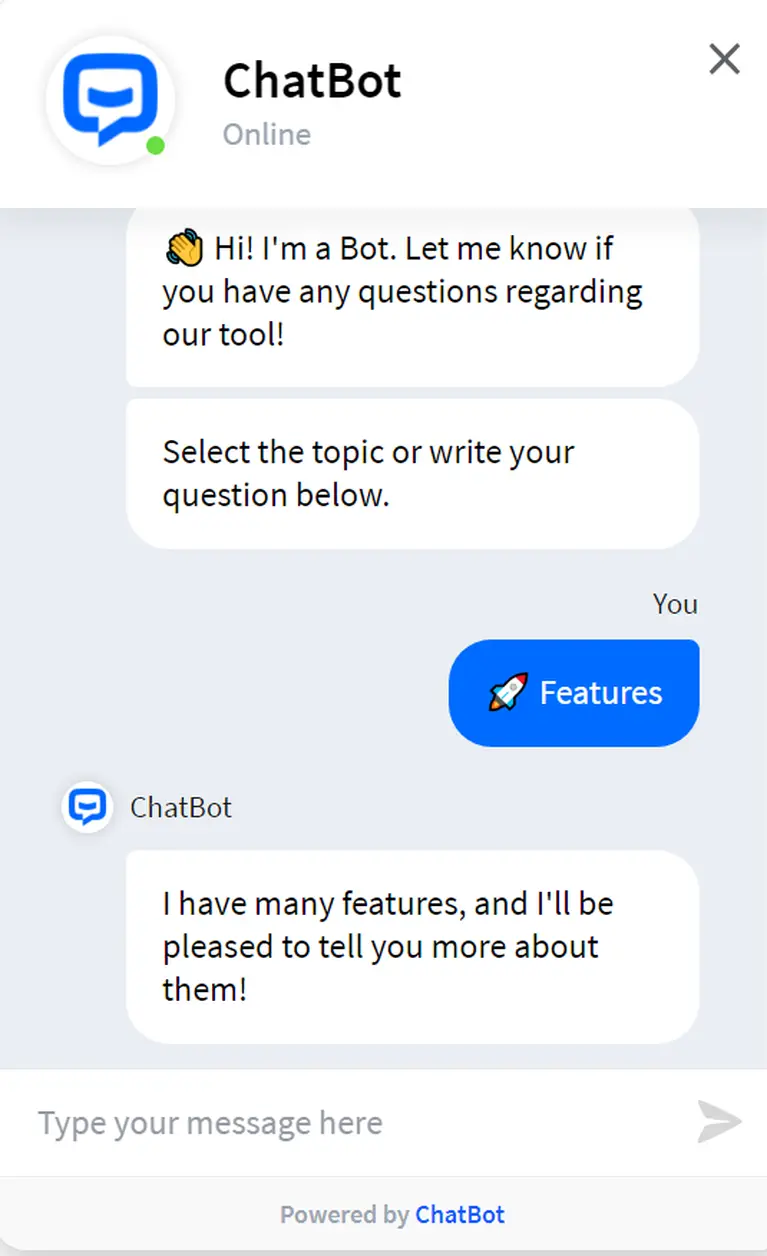
15. Content And Text Readability
Now more than ever, it is important to have this metric tracked from time to time. People are interested in reading only quality, creative and original content.
But how do you exactly measure the quality of your website content? Clear takeaways and actionable content is the key to this.
- Yoast's readability score can help you determine how easy or difficult the content on your website is. It also highlights improvement areas to correct them.
- Use Clearscope to determine the relevance of your content for the search intent.
- TextInspector is another tool you can use to measure your readability; It uses multiple metrics to arrive at the score.
Here’s a screenshot of Yoast showing content readability:
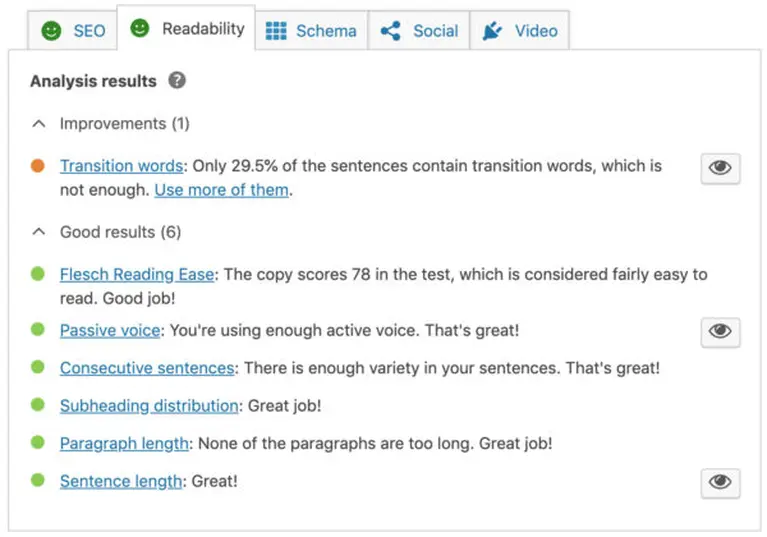
16. Core Web Vitals
Google has made user-centric performance metrics a vital yardstick when ranking a webpage on its search engine. It has become essential for brands to make user-centric websites and provide a breathtaking user experience while they are on the website.
Poor UI & UX is also a major reason some websites don't rank. The three main aspects of core web vitals defined by Google that is responsible for better ranking are:
- First Input Delay is the responsiveness and the experience a user gets after interacting with a website for the first time.
- Cumulative Layout Shifts - This measures the unexpected layout shift when a user is on a website. It measures the amount from the visible page content.
- Largest Contentful Paint - monitors perceived page load speed and indicates when the page's primary content has most likely loaded in the page load timeline.
You can use GTmetrix to optimize your core web vitals:
Read: The Role of UX in Enterprise SEO

17. Organic Click-through-rate
Organic clicks can be measured in a score that determines how much your search traffic is organic compared to the total number of clicks available. This is calculated based on your website's ranking position and the total search volume for a targeted keyword.
You can use tools to determine where your website ranks for all the intended target keywords. There are many ways to calculate your brand's organic market share. Here are a few tools you can use to find the same:
- Carina by Terakeet is a unique tool that not only measures your organic market share but provides a trend analysis based on your past and present scores.
- SEMrush helps check online visibility and provides a comparative analysis of your and your competitors'.
Here’s a screenshot of SEMrush analyzing a competitor’s domain:
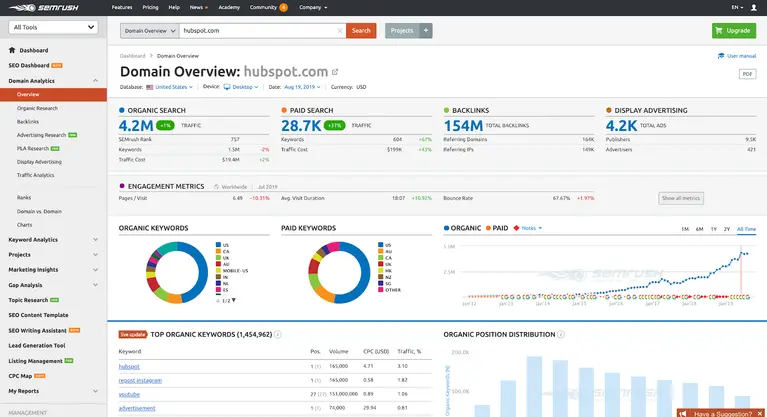
18. Pages Per Visit
This metric will tell you how many pages a user explored on your website. Holding on to these metrics is important as it'll help you redefine your web pages so that your visitors can get through the conversion funnel.
While driving more traffic is the first step to better ranking, convincing the same visitors to take call-to-action is just as necessary and important.
This again drives down to how engaging your pages are and how interactive your website is.
- Have an intuitive page layout and ensure the navigation through the website is easy.
- Use internal links to divert your visitors to check out information on other website pages.
- Add surveys, videos, testimonials, and other interactive and impactful content to your pages to ensure they are interested in exploring more.
Here’s an example of internal links that link to other pages of the website:

19. Geo-Targeted Keywords
When creating your website and optimizing it, you should consider adding geo targetted keywords. This is a very crucial part of local SEO.
For instance, if you own a vegan restaurant in Brazil and add the right geo-targeted keywords, you can ensure that people searching for the same come across your restaurant.
If they type either vegan restaurants in Brazil or Brazil, your food business pops up. You have to add the same in website content and tags.
Remember these:
- If you have more than one branch for your business, always include all the other places in keywords. For this, you have to add the geographical areas in your keywords.
- Once you put in your targeted keyword, Google's Keyword Planner will help you pick the right ones based on the location you are looking at.
- Add these keywords in headings, metadata, meta description, tags, and website content.
Here’s a screenshot of Google’s Keyword Planner showing geo-targeted keywords:

20. Internal Linking
Google is, after all, a bot. While it does all it can to crawl and index your pages, there is no harm in doing your part as a brand to fetch that information to the bot. This makes your ranking process faster and better.
When you hyperlink two pages to the same website, it is internal linking. Internal links organize and structure your website's architecture. It enhances the content context and helps Google understand the content hierarchy.
Some tools that you should use for this task are:
- Link whisper crawls through all your pages and throws up a report highlighting the gaps, which you can use to add internal links.
- Interlinks manager is a budget-friendly tool that creates automatic internal links based on your keywords.
- Internal Link Juicer lets you choose your anchor text and keyword gap, making them authentic and unique.
Here’s a screenshot of Interlinks manager:

Read: How Internal Linking Affects Your SEO?
Key Takeaways
- Backlinks toxicity score helps you determine healthy backlinks that can be retained and should block the rest immediately.
- Concentrate on creating engaging content with a better user experience and unique content. Duplication can lead to a negative impact on your position on SERP.
- Optimize your keywords using short-tail, long-tail, and geo-centric keywords for better local SEO.
- Identify and rectify duplicate content by either replacing it with unique content or blocking what has already been published.
- Remember to monitor your scrolls and find block points to remedy them.
ABOUT THE AUTHOR:
Brice Decker

Brice has been handling marketing projects for more than 12 years and he is providing consulting services on SEO, Social Media and PPC. He has a huge expertise in working at large corporations including Accenture Interactive & PwC Digital Services.
ABOUT THE AUTHOR:
Brice Decker

Brice has been handling marketing projects for more than 12 years and he is providing consulting services on SEO, Social Media and PPC. He has a huge expertise in working at large corporations including Accenture Interactive & PwC Digital Services.
Related Post
Tips to Choose Local SEO Agency
Common Google My Business Mistakes
Effect of Covid on Local Marketers
Video Marketing for Local Businesses
Pr Outreach for Local Businesses
Tips to Rank on Google Local 3-Pack
Metrics to Track in Local SEO Audit
SMM Benefits for Local Businesses
Local SEO Tips to Drive Foot Traffic
How Local SEO Firm Save Your Money
Local 3-Pack for Small Businesses
Content Type That Helps Local SEO
Offline Advertising Tips for Local Businesses
Tips to Handle Local Competition
Tips to Gain Quality Links for Local SEO
Promote Local Businesses Using Instagram
Increase Site Speed of Local Businesses
Do Local Businesses Need a Website
Business That Benefit From Local SEO
Technical SEO for Local Businesses
Optimize for Google Local 3-Pack
Hyperlocal Marketing for Business Growth
Tips to Promote Local Biz on Facebook
Local SEO Mistakes Moving Companies Make
Local Business Directories Benefits and Tips to Use
Blogging Tips for Local Businesses